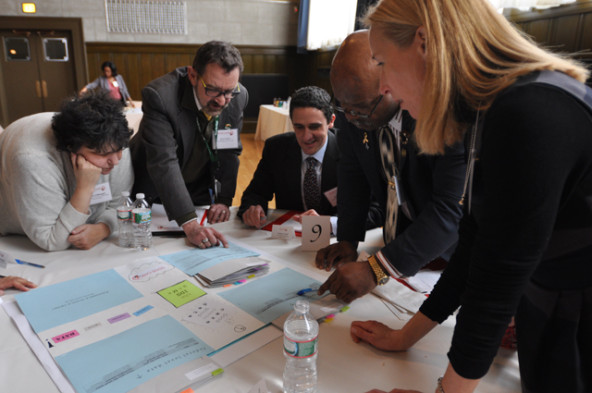Fundamental to successful health-creating initiatives are people—people who collect and interpret data, facilitate town-hall meetings, strive to understand community politics and culture, implement and interact with the initiative, and of course make up the community the initiative aims to serve. Each person comes with their own cares, stresses, and interests, and yet all must work together to successfully implement, evaluate, and evolve new programs.
These people come together to form teams. These teams, such as initiative evaluation teams like my former team at the Institute of Medicine, are most successful and transformative when they are diverse in expertise, skills, perspective, and culture, and include both program implementers and community members. With diversity, however, comes the potential for power struggles, bias, and misunderstanding. We have all been in situations where relationships with colleagues make or break success. Thus teams have the power to either unlock deep potential and creativity, or keep us stuck, insecure, and reacting to patterns of the past.

In his book The Fifth Discipline, systems scientist Peter Senge notes: “When you ask people about what it is like being part of a great team, what is most striking is the meaningfulness of the experience. People talk about being part of something larger than themselves, of being connected, of being generative.”
Great teams are generative. They identify and evolve ideas and relationships using a continuous process of deep listening, collective inquiry, dialogue, prototyping, and reflection to maintain learning and innovation. Teams that can do this produce and test potential solutions more quickly and—by engaging with each other and the community they are working with—can adapt more efficiently.
Generative teams are transformative at both the individual and systemic level. They extend each members’ capacity to understand and create, allowing them to perform better collectively than they could individually. Applied to community partnerships and partnership evaluation, this approach creates a shared commitment to creative solutions and responses that are deeply grounded in community values.
 A generative team engaging around common intent. (Photo by Berly Laycox)
A generative team engaging around common intent. (Photo by Berly Laycox)
Generative teams don’t just happen. Groups must cultivate them by design and pay attention to creating, monitoring, and maintaining them; team development should be as intentional and important as sound financial procedures. Through my experience working on a generative team, training as a qualitative researcher, and studying the work of Senge and his colleague, economist Otto Scharmer, I’ve gleaned four practices for cultivating these kinds of teams. Continually engaging in these practices helps build and sustain teams that can initiate with common intent; sense emerging needs and solutions; and collectively prototype, create, and evolve innovative health models and relationships.
1. Practicing authenticity: Individuals must develop an ongoing self-reflection practice of understanding their true self and purpose, and then operate from that more-honest place. By contrast, inauthenticity, which favors self-promotion and preservation, involves hiding thoughts and opinions to support what individuals think others want to hear. Author and lecturer Brené Brown, notes the difficulty of this “daily practice of letting go of who we think we're supposed to be and embracing who we are.” As team members become more and more themselves, and foster genuine relationships, stronger connections emerge between them, fear and power dynamics lessen, creativity flourishes, and the collective potential of the team improves.
2. Engaging in deep listening: Generative teams practice deep listening as they focus on their common intent. Qualitative researchers learn the same: to authentically listen and observe. Part of the reason is so that they can tune their mind as a research instrument for objective, disciplined inquiry; it also helps them recognize, monitor, and understand the deeply entrenched assumptions and biases that they and others bring to situations. Routine can enhance listening—practice, listening-quality check-ins, and bias reflection through journaling can all help. Once team members can recognize and understand assumptions and judgments, they can suspend them, be fully open to contributing to the team’s collective insight, and immerse themselves in the people and places they are trying to effect.
3. Creating spaces for collective reflection and dialogue: Generative teams create spaces conducive to reflection, gaining insight, and engaging with each other to act collectively on those insights; they intentionally commit time, space, and energy to participate in co-reflection to make sense of situations they face. Entering these spaces, participants try to practice authenticity, deeply listen, remove titles and hierarchies, let go of positions and views, see themselves in others, and value the contribution of each individual. This way, teams enter into dialogue or “thinking together” that draws out insights not individually attainable and that crystalizes action that emerges from these insights.
4. Aligning and acting on shared vision: From a shared vision grounded in collective insight and intent, generative teams move ideas to action through prototyping, quickly trying out ways to collectively take next steps toward the vision they hope to create. For example, if a team formed around the common intent of increasing a sense of community through the use of public spaces, and the idea emerged that more trash cans would create cleaner and more-inviting public spaces, then a prototype would be to place a trash can in a community space, observe how the community uses it, and then feed insight from that test into the next prototype. The prototype—a single trash can—is to inform future action; it is not meant to determine the exact placement of all trash cans in the area, raise funding, or explore possible models and vendors of trash cans before action. The prototype creates the potential for continuous feedback and learning between the team and community members using the preceding principles of deep listening, collective inquiry, dialogue, and reflection.
How can we give generative team cultivation the attention it deserves? Initiative leaders can:
- Give someone on the team the role of “team-builder”—someone responsible for designing, implementing, and monitoring activities and spaces aimed at enhancing listening, reflection, and collective dialogue. This could be the same person throughout the course of a project, or people could rotate every few months. Establishing this role will better ensure that team development doesn’t fall through the cracks.
- Schedule consistent activities for improving team skills. This includes traditional, fun, team-building activities, but it’s imperative to the success of your project that you set aside time to hone listening skills and discuss the future you hope to attain together.
- Set agreed-on principles for team meetings that facilitate entering into dialogue. For example, you could decide that before anyone responds to someone else’s comment or instantly critiques their viewpoint, they must either first take a brief moment of silence to reflect on their reactions, or ask a follow-up question or build on the previous person’s comment (“yes, and …”). These challenges help habitualize good listening and empathy skills.
In addition, we need to create more opportunities and spaces for communities, implementers, funders, and evaluators to come together, listen together, and together explore the future they hope to create. Imagine setting up regular formal and informal listening sessions, workshops, forums, interviews, or site visits for dialogue between communities, implementers, and funders.
People can make or break initiatives for change. Those looking to create health should work to suspend assumptions, agendas, and bias while engaging with the communities they aim to support. They should ask and deeply listen for both emerging needs and solutions from the community, and then continuously prototype, evaluate, and evolve these solutions together with the community. The resulting generative teams will create a system for learning and innovation that has the potential for great transformation.
Support SSIR’s coverage of cross-sector solutions to global challenges.
Help us further the reach of innovative ideas. Donate today.
Read more stories by Margaret A. Hawthorne.

